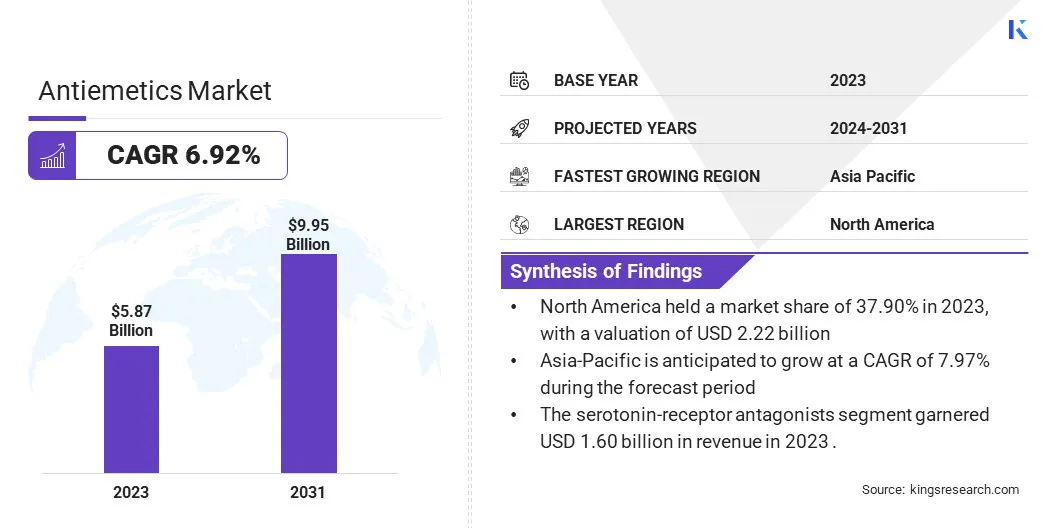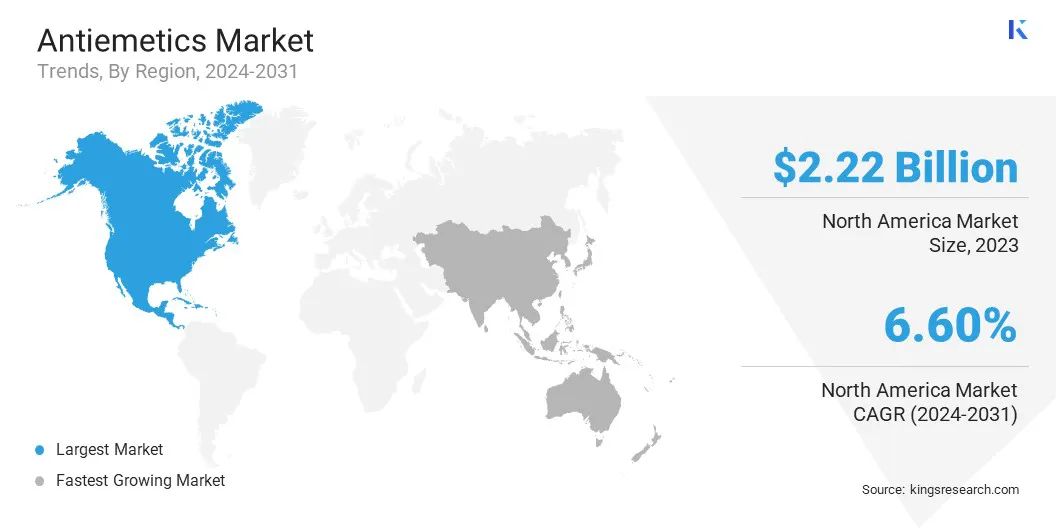Antiemetics Market Size
The global Antiemetics Market size was valued at USD 5.87 billion in 2023 and is projected to grow from USD 6.23 billion in 2024 to USD 9.95 billion by 2031, exhibiting a CAGR of 6.92% during the forecast period. The growth of the market is mainly driven by increasing incidence of cancer and the growing demand for chemotherapy, bolstered by an aging population that is prone to nausea.
Innovations in drug formulations, such as convenient administration methods and combination therapies, are expanding the range of available treatment options. Additionally, advancements in healthcare infrastructure and rising awareness of supportive care needs contribute to market growth, thus enhancing patient outcomes and treatment efficacy.
In the scope of work, the report includes solutions offered by companies such as Pfizer Inc., Cipla Inc., Merck KGaA, Eagle Pharmaceuticals, Inc., Johnson & Johnson Services, Inc., GlaxoSmithKline plc, Astellas Pharma Inc., GLENMARK PHARMACEUTICALS LTD., Viatris Inc., Baxter, and others.
The antiemetics market is poised to witness significant growth, largely due to an increasing incidence of cancer and chronic diseases that necessitate chemotherapy, a treatment often associated with nausea and vomiting.
- According to the American Cancer Society, it was estimated that in 2023, there would be around 609,820 cancer related deaths and 1,958,310 new cancer cases in the U.S.
This demand is bolstered by advancements in drug formulations, which include prolonged effects and convenient administration methods such as transdermal patches and orally disintegrating tablets. Furthermore, the rise in the geriatric population, which is more prone to conditions that induce nausea, is further fueling market expansion.
Emerging trends such as the development of combination therapies and the expansion of healthcare infrastructure are influencing market dynamics by enhancing treatment efficacy and patient compliance. With ongoing innovations and therapeutic advancements, the antiemetics market is likley to witness substantial growth.
Antiemetics are medications aimed at preventing or alleviating nausea and vomiting. They play a crucial role in managing side effects induced by chemotherapy, anesthesia, motion sicknes and other conditions. These drugs function by targeting the biological pathways responsible for triggering these symptoms, thereby improving patient comfort and enhancing adherence to treatment regimens.
They are vital in supportive care by reducing the impact of nausea and vomiting in patients undergoing medical procedures or experiencing illness-related symptoms. Antiemetics are available in various formulations, each tailored to address specific causes and severity levels of nausea, thereby meeting diverse medical needs.

Analyst’s Review
Growing drug approvals and research activities are facilitating market expansion. Various industry participants are actively researching, developing, and securing approvals for new antiemetic drugs, which are anticipated to significantly contribute to market growth.
- For instance, in March 2022, Taiho Pharmaceutical Co., Ltd. received authorization to market and manufacture Arokaris, a selective NK1 receptor antagonist designed to manage gastrointestinal symptoms associated with cancer chemotherapy. Similarly, in April 2022, Evoke Pharma, Inc., obtained new drug product exclusivity from the U.S. Food and Drug Administration (FDA) for Gimoti (metoclopramide) nasal spray.
This exclusivity under the Hatch-Waxman Act Grants Evoke exclusive marketing rights for a period of three years, thereby safeguarding the product from generic competition.
Key players in the antiemetics market are propelling growth through continuous research and development efforts and by securing regulatory approvals for innovative drugs. These achievements enhance treatment options and enhance market competitiveness, underscoring the importance of robust R&D and strategic regulatory management in fostering market expansion and advancing patient care.
Antiemetics Market Growth Factors
The increasing incidence of chronic diseases such as cancer, which frequently necessitate chemotherapy, is boosting the demand for antiemetic drugs. Chemotherapy-induced nausea and vomiting (CINV) is a prevalent and distressing side effect that severely impact patients' quality of life and their willingness to continue with treatment.
Effective antiemetic treatments are essential in mitigating these symptoms, thereby enabling patients to adhere to their chemotherapy regimens without interruption. By improving patients' comfort and adherence to cancer therapies, antiemetic drugs play a crucial role in the overall management and success of cancer treatment, thereby fueling the growth of the antiemetics market.
The stringent regulatory requirements for the approval of new drug formulations and therapies are expected to hinder the market growth. This ongoing challenge hampers the introduction of innovative treatments, creating barriers to market expansion.
However, key players are actively addressing this issue by investing heavily in robust clinical trials and refining regulatory strategies to streamline approval processes and ensure compliance with evolving standards. They collaborate closely with regulatory bodies and advocate for standardized guidelines to expedite market entry and enhance accessibility to novel antiemetic solutions. These efforts are crucial for navigating regulatory complexities and fostering innovation to meet growing healthcare demands effectively.
Antiemetics Market Trends
The antiemetics market is witnessing a notable trend toward the development of new and improved formulations, with the objective of enhancing patient compliance and comfort. Innovations include drugs with longer-lasting effects and fewer side effects, which significantly improve patient outcomes.
Additionally, there is a growing focus on developing more convenient administration methods, such as transdermal patches and orally disintegrating tablets. These methods are particularly beneficial for patients who have difficulty swallowing pills or who require consistent medication delivery over time. These advancements improve the overall patient experience and ensure more effective management of nausea and vomiting, thereby aiding market growth.
- For instance, in October 2023, Astellas Pharma Inc. showcased research findings at the European Society for Medical Oncology (ESMO) Congress 2023, including an abstract addressing the impact of antiemetics on gastric injury and emesis frequency in ferrets. Such presentations by industry leaders are anticipated to increase awareness of antiemetic drugs, which is likely to bolster market growth in the coming years.
The growing adoption of combination therapies that integrate various antiemetics with distinct mechanisms of action is expected to fuel market growth. This strategic approach aims to maximize efficacy in preventing and managing chemotherapy-induced nausea and vomiting (CINV) compared to traditional monotherapy.
By addressing multiple pathways involved in CINV, these combination therapies are enhancing treatment outcomes and improving patient satisfaction. This trend is propelling market growth by fostering innovation in treatment protocols and expanding the therapeutic options available to healthcare providers. As healthcare professionals increasingly recognize the advantages of combination therapies, their widespread adoption is anticipated to augment market expansion.
Segmentation Analysis
The global market is segmented based on drug, application, sales channel, form, and geography.
By Drug
Based on drug, the market is categorized into serotonin-receptor antagonists, glucocorticoids, anticholinergics, NK-receptor antagonists, dopamine receptor antagonists, cannabinoids, antihistamines, and others. The serotonin-receptor antagonists segment garnered the highest revenue of USD 1.60 billion in 2023, as it offers effective treatment options for managing chemotherapy-induced nausea and vomiting (CINV) and other nausea-related conditions.
Drugs, such as ondansetron and granisetron, target serotonin receptors in the gastrointestinal tract and central nervous system, thereby reducing the incidence and severity of nausea and vomiting. Their widespread use in clinical settings, coupled with ongoing advancements in formulation and delivery methods, enhances patient adherence to treatment regimens. As healthcare providers increasingly recognize the efficacy and safety of serotonin-receptor antagonists, their adoption continues to support segmental expansion.
By Application
Based on application, the market is categorized into chemotherapy, gastroenteritis, post-operative surgery, and others. The chemotherapy segment captured the largest antiemetics market share of 45.90% in 2023. Chemotherapy remains a primary treatment modality for various cancers, contributing significantly to the demand for antiemetic medications.
These drugs are essential in managing chemotherapy-induced nausea and vomiting, which are common and debilitating side effects of cancer treatment. The consistent rise in global cancer incidences underscores the surging need for effective antiemetics. Key advancements in chemotherapy protocols, such as the introduction of more potent and targeted therapies, necessitate concurrent improvements in supportive care, including antiemetic management.
The chemotherapy segment is projected to witness substantial expansion by ensuring better patient adherence, reducing treatment interruptions, and enhancing overall treatment outcomes.
By Sales Channel
Based on sales channel, the antiemetics market is divided into retail pharmacy, hospital pharmacy, and online retail. The retail pharmacy segment is expected to garner the highest revenue of USD 4.52 billion by 2031. As antiemetic medications become increasingly available over-the-counter (OTC) or through prescription fulfillment at retail pharmacies, accessibility and convenience for patients are significantly enhanced.
Retail pharmacies serve as key distribution points, providing a wide range of antiemetic drugs to meet varying patient needs, from standard nausea relief to specialized treatments for chemotherapy-induced nausea and vomiting (CINV). The expansion of retail pharmacy networks, coupled with increasing consumer awareness and healthcare access, leads to increased demand.
The capacity of retail pharmacies to cater to diverse patient populations and offer personalized medication counseling further promotes segmental expansion and supports improved patient outcomes.
Antiemetics Market Regional Analysis
Based on region, the global market is classified into North America, Europe, Asia-Pacific, MEA, and Latin America.

North America antiemetics market share stood around 37.90% in 2023 in the global market, with a valuation of USD 2.22 billion. This growth is largely attributed to various factors such as widespread availability, economic stability, and high consumer awareness regarding healthcare. Key drug launches, along with an increasing prevalence of cancers and gastroenteritis, further contribute to regional market growth.
- For instance, according to the article published by the Canadian Institutes of Health Research in May 2022, Ondansetron, a 5-HT3 antagonist approved in Canada as an antiemetic, is utilized for managing nausea and vomiting associated with chemotherapy and post-operation.
The regional market benefits from a significant presence of market players and manufacturers, particularly in the United States. These factors collectively boost the demand for antiemetic drugs, thereby supporting regional market expansion and ensuring accessibility to effective treatments for nausea and vomiting across North America.
Asia-Pacific is anticipated to witness substantial growth at a CAGR of 7.97% over the forecast period, largely due to increasing healthcare infrastructure development and rising disposable incomes among the population. Additionally, advancements in cancer treatments and supportive care are leading to increased demand for antiemetic medications in the region.
The growing elderly population, along with changing dietary habits and lifestyle factors, further augment regional market expansion. Moreover, collaborations between international pharmaceutical companies and local healthcare providers are facilitating greater access to effective antiemetic therapies, thereby enhancing treatment outcomes and bolstering domestic market growth.
Competitive Landscape
The global antiemetics market report will provide valuable insight with an emphasis on the fragmented nature of the industry. Prominent players are focusing on several key business strategies such as partnerships, mergers and acquisitions, product innovations, and joint ventures to expand their product portfolio and increase their market shares across different regions.
Companies are implementing impactful strategic initiatives, such as expanding services, investing in research and development (R&D), establishing new service delivery centers, and optimizing their service delivery processes, which are likely to create new opportunities for market growth.
List of Key Companies in Antiemetics Market
- Pfizer Inc.
- Cipla Inc.
- Merck KGaA
- Eagle Pharmaceuticals, Inc.
- Johnson & Johnson Services, Inc.
- GlaxoSmithKline plc
- Astellas Pharma Inc.
- GLENMARK PHARMACEUTICALS LTD.
- Viatris Inc.
- Baxter
Key Industry Development
- January 2023 (Product Launch): Glenmark Pharmaceuticals Ltd launched AKYNZEO I.V., a unique I.V. injection formulation designed to prevent chemotherapy-induced vomiting and nausea.
The global antiemetics market is segmented as:
By Drug
- Serotonin-receptor Antagonists
- Glucocorticoids
- Anticholinergics
- NK-receptor Antagonists (Substance-P)
- Dopamine Receptor Antagonists
- Cannabinoids
- Antihistamines
- Other
By Application
- Chemotherapy
- Gastroenteritis
- Post-Operative Surgery
- Others
By Sales Channel
- Retail Pharmacy
- Hospital Pharmacy
- Online Retail
By Form
- Capsule & Tablets
- Powder
- Oral Liquid
By Region
- North America
- Europe
- France
- U.K.
- Spain
- Germany
- Italy
- Russia
- Rest of Europe
- Asia-Pacific
- China
- Japan
- India
- South Korea
- Rest of Asia-Pacific
- Middle East & Africa
- GCC
- North Africa
- South Africa
- Rest of Middle East & Africa
- Latin America
- Brazil
- Argentina
- Rest of Latin America


